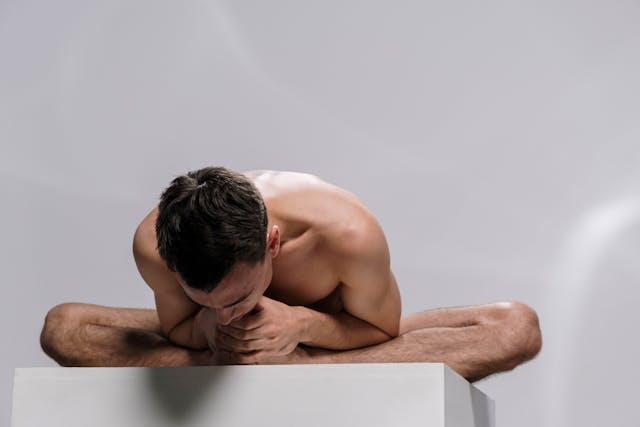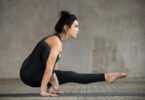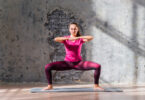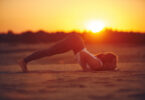Introduction
Naked yoga, often seen as a bold and unconventional fitness practice, is gaining popularity because it fosters more profound connections with the body, enhances personal acceptance, and improves overall wellness. This article explores the multifaceted benefits and considerations of naked yoga.
The History of Naked Yoga
Naked yoga has roots that extend back to ancient times, particularly within some sects of Indian spiritual practices. Aimed initially at rejecting worldly goods and societal norms, these practices emphasized purity and spiritual growth through body exposure.
Benefits of Naked Yoga
Practicing yoga without the barrier of clothing enhances skin breathing, increases body awareness, and improves flexibility. Participants often report significant improvements in self-esteem and body image as they learn to appreciate their bodies in their natural state. This article on creating a yoga practice offers a solid foundation for those new to the concept.
Naked yoga, while a less conventional practice, offers several unique benefits that distinguish it from traditional yoga done in clothing. Here are some of the primary advantages:
- Increased Body Awareness: Practicing yoga without the barrier of clothing can significantly enhance body awareness. Participants are more attuned to every part of their body, noticing subtle movements and alignments often overlooked when wearing clothes. This heightened awareness can lead to better posture and technique.
- Promotion of Body Positivity and Acceptance: Naked yoga can be a powerful exercise in self-acceptance, helping practitioners embrace their natural bodies without judgment. This can foster a positive body image and boost self-confidence.
- Improved Skin Health: Without the confinement of clothing, the skin breathes more easily. This can be particularly beneficial in yoga, where increased circulation and sweating are joint. Clothing can trap sweat and bacteria against the skin, whereas naked yoga allows for immediate evaporation and reduces skin irritations.
- Deeper Connection with the Environment: Practicing yoga nude can enhance the feeling of being one with the environment, indoors or in nature. Direct contact with the air, mat, or earth can be grounding and intensify the spiritual and physical connection that yoga promotes.
- Less Restriction: Clothing can sometimes restrict movement and flow during yoga. Practicing without these physical barriers allows for more accessible and fluid movements, which can enhance the effectiveness of the yoga poses and increase flexibility and reach.
- Thermal Regulation: During intense practice, body temperature can rise, and clothing might cause overheating. Naked yoga allows for natural temperature regulation, which can be more comfortable and effective for maintaining endurance and energy levels.
- Community and Social Bonds: Participating in naked yoga classes can create a sense of community among practitioners, built on mutual respect and shared experiences. This can diminish feelings of isolation and promote social well-being.
Psychological Impact
The practice can profoundly impact one’s mental health by reducing anxiety and depression and fostering a positive body image. It encourages practitioners to confront feelings of shame and develop a more compassionate relationship with their bodies.
How to Practice Naked Yoga
Starting naked yoga can be daunting. It’s recommended to begin at home or in a supportive group setting where privacy and comfort are prioritized. Tips on creating a conducive environment can help those looking to set up a yoga space at home.
Practicing naked yoga can be a liberating experience, but it’s essential to approach it with sensitivity and preparation, especially if you’re new to the practice. Here are some steps to help you start your naked yoga journey safely and confidently:
- Find a Comfortable Space: Choose a private, comfortable environment where you won’t be disturbed. This could be a secluded part of your home or, if privacy allows, a quiet spot in nature. Ensure the space is clean and free from distractions.
- Set the Atmosphere: Consider the ambiance of your practice space. You might want to include calming music, dim lighting, or incense to create a relaxing and inviting atmosphere. This can help ease any initial discomfort and promote relaxation.
- Use a Non-Slip Yoga Mat: Since you’ll be practicing without the grip provided by clothing, it’s crucial to use a high-quality non-slip yoga mat to prevent accidents or discomfort, especially when performing poses that require more balance.
- Warm Up: Begin with gentle stretches and breathing exercises to warm up your body. This helps prevent injury and prepares your body for more intense poses.
- Choose Appropriate Poses: Start with poses you are comfortable with. Simple poses like CChild’sPose, Downward Dog, or Mountain Pose can be good starting points. As you become more comfortable, you can gradually introduce more complex poses.
- Focus on Your Breath: Breathing is a central element of yoga. Concentrate on deep, controlled breaths to maintain a calm mind and increase your connection to your body.
- Practice Mindfulness and Acceptance: During your practice, engage in mindful meditation to enhance body awareness and self-acceptance. Acknowledge any discomfort or negative thoughts and gently let them go, focusing back on your breath and posture.
- Hydrate and Maintain Hygiene: Stay hydrated and clean your mat after every session to keep the practice safe and hygienic.
- Consider Professional Guidance: If you’re unsure about starting independently, consider seeking a class or a workshop. Specialized naked yoga classes offer a safe environment and professional guidance. This can also be a great way to meet a community of like-minded practitioners.
- Respect Your Boundaries: Always listen to your body and respect your comfort limits. Naked yoga should feel free and positive, not forced or uncomfortable.
Choosing the Right Environment
The environment for naked yoga should be safe, private, and warm to ensure comfort and ease. It’s important to use mats and possibly have towels on hand for hygiene and comfort.
Common Styles of Naked Yoga
There are several styles of naked yoga, each focusing on different aspects of the practice. Exploring the essence and practice of Hatha yoga can provide insights into one style suitable for naked yoga.
Dress Code and Etiquette
While the practice itself involves nudity, most naked yoga sessions have rules about behavior and interaction to maintain a respectful and non-sexualized environment.
Legal Considerations
Practicing naked yoga in public or semi-public spaces can have legal implications depending on local laws and public decency statutes. It’s important to understand these before engaging in outdoor or open-group practices.
Naked Yoga Retreats and Classes
Many wellness centers and yoga studios offer specialized retreats and classes for those interested in exploring naked yoga in a structured, professional environment. For a tailored experience, consider senior-friendly yoga retreats.
Naked yoga retreats and classes offer a unique opportunity for deepening yoga practice in a way that encourages body positivity and self-acceptance. If yyou’reinterested in exploring naked yoga in a group setting, here you need to know about retreats and classes:
Naked Yoga Classes
Naked yoga classes are typically held in a private, secure environment to ensure the comfort and privacy of all participants. These classes can be found in some yoga studios, wellness centers, or through specialized organizations that promote body positivity. Here are some key aspects:
- Privacy and Security: Classes are usually conducted in a closed setting, where privacy is strictly maintained.
- Inclusivity: Most naked yoga classes aim to be inclusive and non-judgmental, welcoming individuals of all body types, genders, and ages.
- Professional Instruction: Instructors are often specially trained in yoga, facilitating a safe and supportive environment for naked practice.
- Community Aspect: Joining a naked yoga class can be a way to meet people with similar interests in yoga, body acceptance, and personal growth.
Naked Yoga Retreats
For those seeking an immersive experience, naked yoga retreats offer a chance to engage with the practice over multiple days, often in serene and natural settings. Retreats usually include daily yoga sessions, healthy meals, and other wellness activities. Key features include:
- Extended Practice: Retreats provide an opportunity to deepen yoga practice without the distractions of daily life.
- Natural Settings: Many retreats are held in beautiful, secluded locations where participants can connect with nature.
- Additional Wellness Activities: In addition to yoga, retreats may offer meditation sessions, workshops on nutrition and body image, hiking, and other activities.
- Community and Connection: Spending several days with a group engaged in similar practices fosters a more profound sense of community and belonging.
Things to Consider
- Research: Before attending a class or retreat, it’s important to thoroughly research the event and its organizers to ensure that they align with your values and expectations.
- Comfort Level: Consider starting with a single class to gauge your comfort level before committing to a longer retreat.
- Guidelines and Etiquette: Be aware of and respect the organization’s guidelines, including those regarding privacy, photography, and conduct.
Safety Precautions
It’s crucial to consider physical and emotional safety when practicing naked yoga. This includes being aware of one’s boundaries and ensuring the practice environment is respectful and secure.
Naked Yoga at Home
Practicing naked yoga at home offers a great way to enjoy the benefits of this unique approach to yoga in a completely private and comfortable setting. Here is a guide on how to get started with naked yoga in the comfort of your own home:
1. Prepare Your Space
- Choose a Private Room: Ensure privacy by using a room where you won’t be disturbed or seen. This might be your bedroom, living room, or a space that provides a secure feeling.
- Set the Atmosphere: Create a calming environment. You might use candles, dim lighting, or an essential oil diffuser to enhance relaxation and focus.
- Comfortable Temperature: Adjust the room temperature to be comfortably warm, considering you won’t have clothing insulation.
2. Gather Your Equipment
- Yoga Mat: Use a high-quality, non-slip yoga mat to ensure safety during poses.
- Towels: Have towels handy for comfort and to manage sweat.
- Hydration: Keep a water bottle nearby to stay hydrated throughout your practice.
3. Plan Your Session
- Choose Your Style: Decide on the type of yoga you want to practice, such as Hatha, Vinyasa, or Yin, which can be nicely adapted to naked yoga.
- Select a Routine: If you are experienced, you can follow a video tutorial, use a yoga app, or create your sequence of poses. Many online resources offer guided practices.
4. Start with a Warm-Up
- Gentle Stretching: Begin with gentle stretches to loosen your muscles and joints, preparing them for more intense poses.
- Breathing Exercises: Incorporate breathing exercises (Pranayama) to center your mind and establish a rhythm for your practice.
5. Practice Mindfully
- Focus on Body Awareness: You might notice different sensations and alignments without clothing. Use this heightened awareness to refine your poses and deepen your practice.
- Embrace Self-Acceptance: Practicing naked is a powerful opportunity to cultivate body positivity and self-love. Notice any self-critical thoughts and gently redirect them to an appreciation for your capabilities.
6. Conclude with Relaxation
- Cool Down: End your session with a cool-down sequence to relax the muscles and slow your heart rate.
- Final Meditation: Lie in Savasana (Corpse Pose) and meditate, allowing your body to absorb your benefits fully.
7. Maintain Privacy and Respect
- Digital Privacy: If you’re using online guides or apps, ensure your practice area is out of view from cameras when not in use.
FAQs
Is naked yoga only for those who are already comfortable with nudity?
No, it’s for anyone open to exploring their body’s capabilities and overcoming personal insecurities.
Are there any age restrictions for practicing naked yoga?
Typically, participants must be over 18 due to the nature of the practice.
Can naked yoga improve relationships?
Yes, it can enhance personal relationships by fostering greater openness and self-acceptance.
How do I find a reputable naked yoga class?
Look for well-reviewed studios that prioritize safety, privacy, and professionalism.
What should I do if I feel uncomfortable during a session?
Feel free to express discomfort and withdraw if the environment doesn’t align with your boundaries.
Conclusion
Naked yoga offers a unique path to physical and mental health that encourages practitioners to embrace their natural selves in a profound and transformative way. By understanding and respecting the practice, one can gain a more accepting and appreciative view of one’s body and capabilities. This guide might interest further reading on enhancing well-being through yoga.







